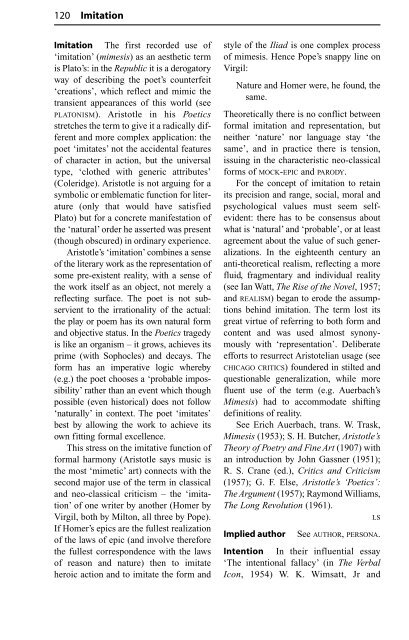The Routledge Dictionary of Literary Terms
The Routledge Dictionary of Literary Terms
The Routledge Dictionary of Literary Terms
Create successful ePaper yourself
Turn your PDF publications into a flip-book with our unique Google optimized e-Paper software.
120 Imitation<br />
Imitation <strong>The</strong> first recorded use <strong>of</strong><br />
‘imitation’ (mimesis) as an aesthetic term<br />
is Plato’s: in the Republic it is a derogatory<br />
way <strong>of</strong> describing the poet’s counterfeit<br />
‘creations’, which reflect and mimic the<br />
transient appearances <strong>of</strong> this world (see<br />
PLATONISM). Aristotle in his Poetics<br />
stretches the term to give it a radically different<br />
and more complex application: the<br />
poet ‘imitates’ not the accidental features<br />
<strong>of</strong> character in action, but the universal<br />
type, ‘clothed with generic attributes’<br />
(Coleridge). Aristotle is not arguing for a<br />
symbolic or emblematic function for literature<br />
(only that would have satisfied<br />
Plato) but for a concrete manifestation <strong>of</strong><br />
the ‘natural’ order he asserted was present<br />
(though obscured) in ordinary experience.<br />
Aristotle’s ‘imitation’ combines a sense<br />
<strong>of</strong> the literary work as the representation <strong>of</strong><br />
some pre-existent reality, with a sense <strong>of</strong><br />
the work itself as an object, not merely a<br />
reflecting surface. <strong>The</strong> poet is not subservient<br />
to the irrationality <strong>of</strong> the actual:<br />
the play or poem has its own natural form<br />
and objective status. In the Poetics tragedy<br />
is like an organism – it grows, achieves its<br />
prime (with Sophocles) and decays. <strong>The</strong><br />
form has an imperative logic whereby<br />
(e.g.) the poet chooses a ‘probable impossibility’<br />
rather than an event which though<br />
possible (even historical) does not follow<br />
‘naturally’ in context. <strong>The</strong> poet ‘imitates’<br />
best by allowing the work to achieve its<br />
own fitting formal excellence.<br />
This stress on the imitative function <strong>of</strong><br />
formal harmony (Aristotle says music is<br />
the most ‘mimetic’ art) connects with the<br />
second major use <strong>of</strong> the term in classical<br />
and neo-classical criticism – the ‘imitation’<br />
<strong>of</strong> one writer by another (Homer by<br />
Virgil, both by Milton, all three by Pope).<br />
If Homer’s epics are the fullest realization<br />
<strong>of</strong> the laws <strong>of</strong> epic (and involve therefore<br />
the fullest correspondence with the laws<br />
<strong>of</strong> reason and nature) then to imitate<br />
heroic action and to imitate the form and<br />
style <strong>of</strong> the Iliad is one complex process<br />
<strong>of</strong> mimesis. Hence Pope’s snappy line on<br />
Virgil:<br />
Nature and Homer were, he found, the<br />
same.<br />
<strong>The</strong>oretically there is no conflict between<br />
formal imitation and representation, but<br />
neither ‘nature’ nor language stay ‘the<br />
same’, and in practice there is tension,<br />
issuing in the characteristic neo-classical<br />
forms <strong>of</strong> MOCK-EPIC and PARODY.<br />
For the concept <strong>of</strong> imitation to retain<br />
its precision and range, social, moral and<br />
psychological values must seem selfevident:<br />
there has to be consensus about<br />
what is ‘natural’ and ‘probable’, or at least<br />
agreement about the value <strong>of</strong> such generalizations.<br />
In the eighteenth century an<br />
anti-theoretical realism, reflecting a more<br />
fluid, fragmentary and individual reality<br />
(see Ian Watt, <strong>The</strong> Rise <strong>of</strong> the Novel, 1957;<br />
and REALISM) began to erode the assumptions<br />
behind imitation. <strong>The</strong> term lost its<br />
great virtue <strong>of</strong> referring to both form and<br />
content and was used almost synonymously<br />
with ‘representation’. Deliberate<br />
efforts to resurrect Aristotelian usage (see<br />
CHICAGO CRITICS) foundered in stilted and<br />
questionable generalization, while more<br />
fluent use <strong>of</strong> the term (e.g. Auerbach’s<br />
Mimesis) had to accommodate shifting<br />
definitions <strong>of</strong> reality.<br />
See Erich Auerbach, trans. W. Trask,<br />
Mimesis (1953); S. H. Butcher, Aristotle’s<br />
<strong>The</strong>ory <strong>of</strong> Poetry and Fine Art (1907) with<br />
an introduction by John Gassner (1951);<br />
R. S. Crane (ed.), Critics and Criticism<br />
(1957); G. F. Else, Aristotle’s ‘Poetics’:<br />
<strong>The</strong> Argument (1957); Raymond Williams,<br />
<strong>The</strong> Long Revolution (1961).<br />
Implied author See AUTHOR, PERSONA.<br />
Intention In their influential essay<br />
‘<strong>The</strong> intentional fallacy’ (in <strong>The</strong> Verbal<br />
Icon, 1954) W. K. Wimsatt, Jr and<br />
LS

















